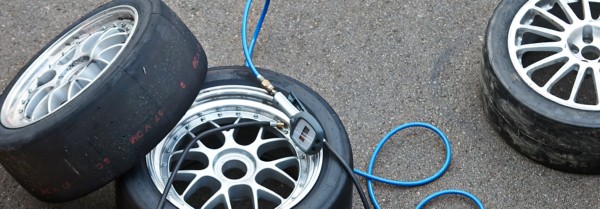How to prep tires for racing
By: Discount Tire

Whether it’s your first time at the track, drag strip, autocross course or rally circuit, Discount Tire is here to break down the logistics on prepping the single most important part of your performance vehicle for competition.
What part is that? Your tires!
Think about it: they’re the only part of your vehicle that actually make (and sometimes lose) contact with the pavement or dirt. Pretty important, if you ask us.
The tools you’ll need:
- Tire pressure gauge
- Tire tread depth gauge
- TPMS (Integrated or external)
- Air compressor
- Extra valve stem caps (because you’ll eventually lose some)
- Stopwatch or lap timer (to document lap times/time slips)
Some tracks or circuits might have an air compressor available at a tire inflation area for general use outside of a pit or bay area, but you don’t want to be that person. You know, the one bugging everyone for a tire pressure gauge or asking what PSI someone with a completely different setup is running.
Before you hit the track you might also want to bear the following in mind:
Competition tire inspection
If you’re not running a brand new set of tires for the first time on your track day, you’re going to want to inspect your current rubber before you put the type of demand on your existing tires that racing or competition driving will create. The very last thing you want is a blowout, which could have a life-threatening impact on you or those around you.
To inspect your tires pre-race, take a look at their wear bars and tread depth (if applicable, as most competition tires already start with 6/32” tread). If you’re seeing exposed cords or next to no tread remaining, you are highly encouraged to skip the track or drag strip outright if there’s even a chance of rain in the forecast.
Most dedicated competition tires have an actual hole for using a tread depth gauge
If you aren’t sure about the condition of your competition tires, feel free to stop by your nearest location on your way to the track for a free inspection.
Competition tire break-in
Especially if you’re running a set of summer or ultra high performance tires that you plan on driving to and from the track on, you’re going to want to break your new tires in before you track them.
While obeying local traffic laws, this can be done on the street with a few rolling 3/4-throttle pulls onto the freeway if you’re eventually going to be taking your car to the drag strip. But if you’re going to be driving or racing on a track, you might want to otherwise normally drive your vehicle around town for a few hundred miles to ensure that any polymers and manufacturing oils in your tire's rubber compound have worn off.
If you’re able to, taking your vehicle around the track at about 75% power for a few laps is another way to make sure they’re good and broken in before you put them through the wringer on a hot lap.
Learn more about breaking in new tires here.
Competition tire heat cycling
Don’t want to wait? Heat cycling can ensure your tires are ready to rip from the moment they’re put on your car. This isn’t something we offer at our stores, but you can order tires from our warehouses with heat cycling already applied to your brand new tires—so that there’s no question about their track-readiness.*
*In select regions
At what PSI should you set your tires at on the drag strip/track/autocross course?
Generally speaking (and we mean very generally) you’re going to want to air your performance/competition tires down about 5 PSI from their suggested air pressure in order to get them to hook their best on the strip or track. This induces a little more flex and traction when you mash the accelerator, which reduces wheel spin. On top of these desirable performance attributes, airing down leaves a little room for your tires to heat up without becoming overinflated, which can have a negative impact on virtually every driving performance aspect.
However, 5 PSI is a starting point. Trial and error is truly the name of the game. Sometimes it even comes down to .5 PSI as a lap time or car-length difference-maker, but that’s a big part of the fun of it!
Know the rules
Before you spend on new competition tires, you’ll probably want to get acquainted with your series or even vehicle class requirements.
Most competition tracks, circuits and events have rules and bylaws that regulate the minimum safety requirements of tires, wheels, and even valve stems.
Now that you know what to expect, have fun out there!
Your nearest location is here to help you re-up on competition tires, ultra high performance tires, summer tires and even specialty OE tire fitments. From inspections to air pressure checks, rotations, rebalances and more, your local Discount Tire/America's Tire can help you safely dial in your ride for your next big day at the track!